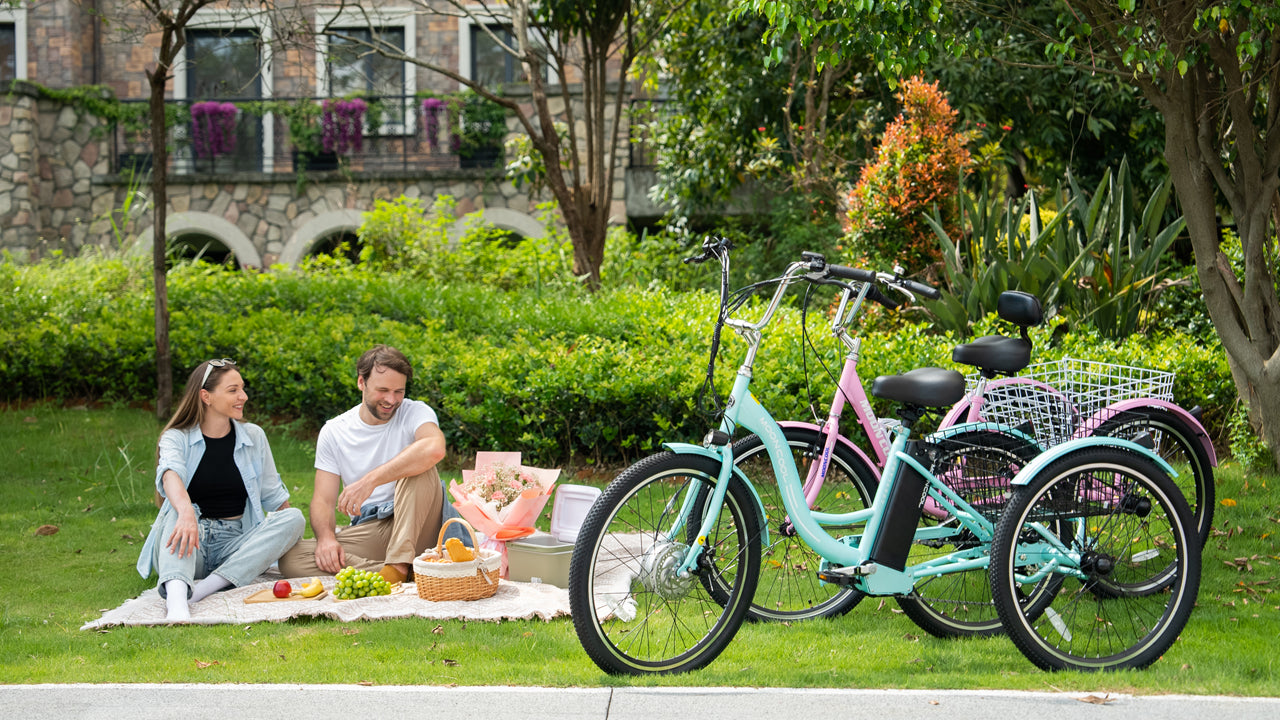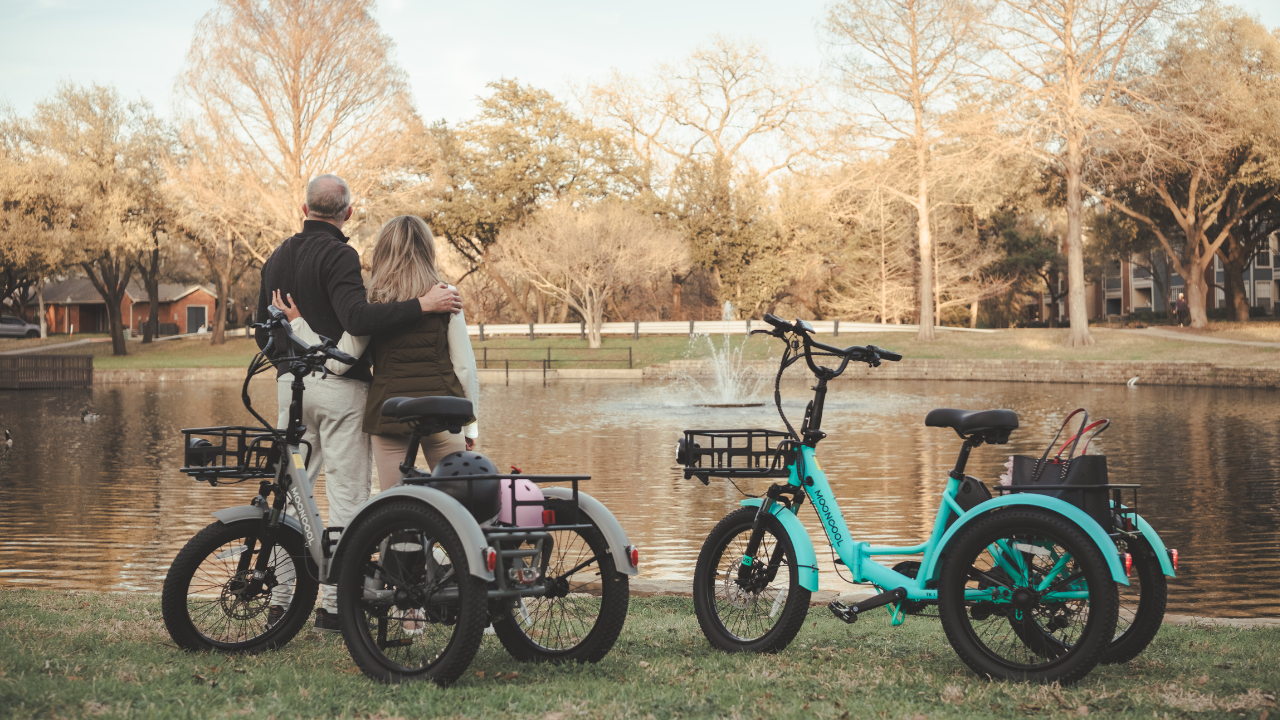Gliding along snowy paths or breezing past long checkout lines while bundled in a toasty cabin, electric tricycles empower older adults to actively run errands and visit friends year-round. However, embracing winter’s possibilities on an e-trike also introduces new precautions compared to fair weather outings. By anticipating and proactively addressing seasonal road hazards, inadequate traction, sub-optimal visibility, and increased physical strains, senior riders will remain safe while making the most of the cooler months ahead.
1. Prep By Layering Protective Winter Riding Attire
Defending against winter’s cold, wind, and storms starts with proper base layers and outerwear that retain heat without limiting mobility. The layering system should include:
- Merino wool and synthetic base layers to wick moisture away from the skin
- Mid layers like fleece and down insulation trap body heat to maintain core warmth
- Outermost weatherproof jackets that block wind chill, rain, and snow
On top heads and extremities:
- Scarves can bundle up necks under helmet straps.
- Earmuffs layered underneath helmet straps prevent ear heat loss while riding.
- Lightweight glove liners, when worn under heavier outer winter gloves, provide warmth while improving the feel and dexterity of operating brakes, gears, and other bike controls compared to a single bulky glove pair.
Finally, ski-style goggles are vital for protecting eyes against icy winds, blowing snow, and sun glare off frozen surfaces. For those needing prescription eyewear, consider transitional photochromic lenses that automatically adjust between dark and light settings. Swapping out regular glasses lenses adds this protective reactive tinting. As backup insurance against sudden visibility issues caused by damage or weather shifts, carrying an extra set of goggles or glasses in bags and compartments proves wise.
Completing winter e-trike prep, lug-soled cycling boots engineered specifically for colder months supply crucial warmth, waterproofing, and enhanced traction over regular footwear. Their grip minimizes slips when walking trouble spots or dismounting onto slippery ground. Cushioning and supportive fit help sustain riding comfort over long distances as well.

2. Cushion Against Bumps & Hidden Obstacles
Traversing winter’s uneven terrain risks toppling some e-trike models or aggravating seniors’ joint pain if the frame lacks shock absorption. Seeking out electric tricycles engineered with front, rear, or dual integrated suspension systems helps smooth out the ride across cracked payment seams, and potholes debris hidden below fresh snow.
Assess Need for Suspension Systems
- Rigid frames risk toppling on uneven terrain
- Suspension better absorbs impacts from cracks, potholes, and debris
- Choose based on current skill and comfort needs
These components compress to independently allow each wheel to react and adapt to changing contours underneath. This cushioning effect greatly improves overall handling, braking grip, cornering stability, and traction control compared to non-suspended models. The slight rocking movement enhanced systems also feel more intuitive for balancing than entirely rigid frames.
Compare Front, Rear or Dual Integrated Suspension
- Independently react to contours and smooth the ride
- Enhance braking grip, cornering stability, and traction
- Feel more balanced than non-suspended models
When comparing suspension configurations as abilities evolve, consider less cushioning provides a more responsive feel for riders able to manually adjust body positioning as needed over time. Meanwhile, highly adjustable air shocks better customize rebound speeds and smoothness levels to match declining flexibility and reaction times.
Consider Responsive Versus Adjustable Systems
- Less cushioning suits riders manually adjusting positions
- Customizable air shocks accommodate declining flexibility
Before relying on luggage for long winter trips, test riding different systems fully loaded determines what best suits current skill, comfort and safety needs.
Test Fully Loaded Weight Distribution
- Assess real-life maneuverability before relying on gear
- Ensure suspension matches winter clothing and accessories
3. Strategize Carrying Additional Weight
Preparing for longer winter excursions means hauling more emergency tools, first aid supplies, phone power banks, and sustenance items along. But piling on accessories randomly could shift the center of gravity and e-trike handling. Determine what gear is absolutely necessary before each ride.
Determine Necessary Emergency Items
- Tools, first aid, power banks, food, water, etc.
- Balance safety and convenience
Concentrate heaviest add-ons like oxygen containers low between both wheels or in wire rear cargo holders. Lighter items can travel up top while secured to racks with cargo netting and sturdy straps that easily adjust.
More tools and suggestions when exercise in winter: How to build a winter emergency kit (and why you should)
Position Heaviest Gear Low and Centered
- Oxygen tanks low between wheels
- Rear wire holders for up to 25 lbs
Secure Lighter Items Up Top
- Use cargo nets and adjustable straps
- Avoid loose swinging items
Distributing weight evenly side-to-side better keeps the electric tricycle balanced rather than risk toppling over while cornering or braking. Also, avoid carrying anything loose that could swing around and cause distractions while riding. Use baskets and holders that fasten loads flush and centered inside the overall frame periphery for optimized stability.
For seniors, test fully loading bags at home before needing emergency items out on the trails. This helps gauge maneuverability impacts ahead of time. Always stay within the maximum recommended weight limits specified by manufacturers too. Carefully prioritizing safety over convenience prevents storage placements likely to negatively influence essential riding reactions in demanding conditions.
4. Vigilantly Track Tire Pressure & Tread Conditions
Closely monitoring tires becomes vital for e-trike safety as winter conditions fluctuate. Use accurate air gauges to routinely check inflation against manufacturer-recommended PSI (pounds per square inch) levels. Underfilled tires wander in steering, accelerate slower, and reduce battery range per charge. Always carry a compact portable pump for quick top-offs in case pressure dips mid-ride.
Investing in preventative tire liners protects against punctures from debris hidden on roads or in snow buildup that could abruptly halt rides. Periodically inspecting tread depth also remains important, as shallower grooves provide less grip and control when braking or cornering on slippery surfaces.

Tire Tread Inspection Guidelines:
|
Tread Depth |
Safety Impact |
Action Needed |
|
Above 4/32 inch |
Optimal traction and braking grip |
Continue riding |
|
3/32 to 2/32 inch |
Slightly less grip when braking |
Schedule replacement soon |
|
Below 2/32 inch |
Greatly increased sliding risk |
Immediate replacement |
5. Outfit For All-Conditions Visibility
As we age, our eyesight tends to decline, making it harder to see road hazards, especially at dawn and dusk. But a few thoughtful precautions allow us to compensate and remain active riders.
|
Alerting Traffic Tool |
Description |
Benefits |
Considerations |
|
Bright Colored Flags |
Tall, flexible fiberglass poles with large high-visibility flags that attach to the rear frame |
Gets the attention of traffic from behind |
May get damaged in falls; need replacement flags over time |
|
Safety Flags |
Smaller, more durable attachable flags, often fluorescent orange |
Inexpensive; reusable |
Limited visibility compared to tall poles |
|
Reflectors |
Adhesive strips or snap-on pieces that reflect light |
Very affordable; easy application |
Effectiveness depends on visibility conditions |
|
Mirrors |
Handlebar-mounted to see traffic |
Provides the ability to check behind |
Limited field of view; proper adjustment |
|
Safety Vest |
A bright mesh vest is worn when riding |
Lightweight to layer; very noticeable |
The vest should fit well without restricting movement |
|
Audible Warning |
Electric horn or bell |
Gets nearby attention fast |
It may startle others if used excessively |
With just small adjustments, fading light or impaired sight need not curb treasured time spent together outdoors cycling. We can pedal confidently through neighborhoods enjoying timeless holiday cheer, not left stranded, missing the nostalgic magic this season offers.
6. Guard Against Overexertion Through Paced Travel
As senior riders of electric trikes, it’s important to conserve energy this winter by pacing ourselves over longer distances. You may not push extremely hard pedaling against brisk winds - that will simply drain your energy faster than in years past. A better approach involves mixing short intense uphill leg workouts with gentler, straight-rolling segments. By monitoring fitness trackers, you can keep heart rates below 70% of age-adjusted maximums. Before embarking on farther rides, bringing nutritional snacks like apple slices and granola bars helps refuel tightening muscles along the way. Thermoses filled with warm broth sustain our core temperature during periodic rests. You learn should be mindful of your limitations - when breathing grows labored or dizziness arises, safely stop immediately rather than attempting to muscle through. Proper rests gather strength so you can continue trike adventures while protecting your long-term health.
There are also some safety measures you can prepare in advance:Safety Tips for Buying Electric Trikes: Choose the Best with Confidence! and I believe these suggestions can help you.
7. Stay Alert to Changing Road Conditions
Navigating neighborhood roads on trikes requires special alertness in winter as conditions morph block by block. Early evening temperature plunges camouflage slick ice beneath innocent-looking damp pavement. Snow-blinded intersections warrant extra precautions - approach slowly while counting five full seconds before crossing, as side traffic may also suffer poor sight lines spotting our entry. High plow piles conceal hidden dangers - veer widely, avoiding concealed potholes and drains underneath while blustery gusts whip up swirls, visually obscuring hazard assessments. Sudden whiteout snow squall? Deploy tinted eyewear shields restoring clarity of vision. Maintain safe positioning from vehicles to limit exposure when side-thrown icy slush sprays unpredictably. Adjusting speed and vigilance to match environmental variables ahead reinforces winter trike safety assurances.
8. Tailor Precautions To Your Region’s Risk Level
Winter weather varies dramatically across different geographies. In areas that only occasionally get light snow flurries, riders need fewer safeguards compared to regions combatting heavy snow drifting several feet high year after year. These sharply differing conditions demand context-appropriate preparations tailored to the probable dangers posed where one lives.
To responsibly embrace winter cycling, first, realistically profile the risk level typically seen in your local riding routes. Winter severity varies greatly by location, so gauge precautions based on average conditions in your area. Once you know the winter traits regularly displayed in your zone, certain advisable precautions become apparent.
Light Snow Just Requires Extra Vigilance
For areas that tend to see light snowfall intermittently, staying alert proves wise without overreacting to each flurry:
- Use tire tread indicators to plan replacement proactively before losing traction unexpectedly on a ride
- Equipping essential visibility tools like LED headlamps smartly boosts hazard perceptions as days darken earlier
- Gradually honing pavement condition profiling skills block-by-block keeps you vigilant for isolated slippery patches
Gear Up for Slick Roads Ahead
Where wintery mixes of freezing rains, dense fog banks, and gradual icy buildups emerge, bolstering stability and vision takes priority:
- Seeking electric trike frames with shock-absorbing suspension systems helps cushion against hidden bumps and improves control when roads get hairy
- Prioritizing studded or snow tires early on supplies key reinforcement for tracking true through slippery turns
- Carrying then routinely double-checking backup lighting prevents getting stranded if sudden visibility drop-offs occur
Brace Yourself for Blizzards
In zones relentlessly pummeled by heavy whiteout blizzards and biting winds, trading some independence for community shields you against the harshest exposure:
- Tap into local winter riding groups early when conditions worsen for reinforced assistance navigating high-risk zones
- Investing right away in customized air shock absorbers offers another layer of defense if caught off guard
- Rigorously bundling up necks, heads, and hands prepares you for unexpected wind chills or accidents

Conclusion
Being thoughtfully prepared opens up winter’s potential for continued discovery and adventure on electric tricycles. Taking proper safety precautions allows us to embrace the season’s changes as opportunities rather than obstacles. By tuning into both the external winter conditions and our own changing capabilities, senior riders can prosper through mindful adaptation. Getting geared up for the conditions and then gracefully rolling with the season’s shifts leads us onward to new three-wheeled journeys of enrichment.















Leave a Comment
This site is protected by hCaptcha and the hCaptcha Privacy Policy and Terms of Service apply.